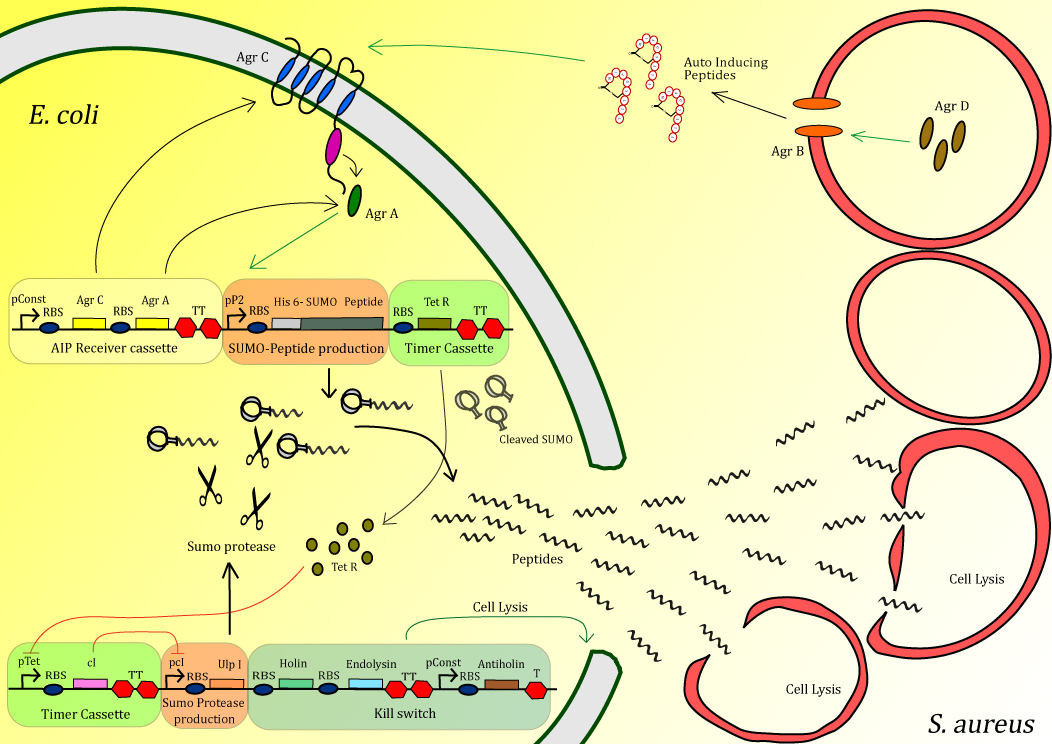Team:TU-Delft/Project
From 2013.igem.org
Jfkooijman (Talk | contribs) |
|||
| Line 7: | Line 7: | ||
<div style="margin-left:30px;margin-right:30px; width:900px;float:left;"> | <div style="margin-left:30px;margin-right:30px; width:900px;float:left;"> | ||
| - | <h2 align="center"> | + | <h2 align="center">Peptidor: Detection and killing of resistant <i>S. aureus</i> using antimicrobial peptides</h2> |
<html> | <html> | ||
| - | + | The bacterium Methicillin-Resistant <i>Staphylococcus aureus</i> causes major problems, especially in hospitals, causing over half a million infections annually in the United States alone. Of the alternative treatments currently under investigation one of the more promising is antimicrobial peptides (AMPs). These small peptides, typically several dozen amino acids in length, bind to and aggregate on the outer-membrane of the target organism and are able to make holes in the membrane at sufficiently high concentrations. The variation in the membrane composition of different organisms makes these peptides highly specific, meaning that infectious bacteria can be killed with little effect on neighboring human cells. Thousands of AMPs are have been discovered in nature and unlike antibiotic chemicals, AMPs can easily evolve as pathogens develop resistance. Using multiple AMPs in combination, can reduce the probability of developing resistance. The Peptidor project consists of an <i>E. coli</i> that can detect <i>S. aureus</i> in order to locally produce and deliver AMPs at the site of infection. Detection is achieved using the native quorum sensing system of <i>S. aureus</i>. Upon detection, AMPs, inactivated by fusion to a SUMO-tag, are overexpressed. After a delay period, introduced through a negative transcriptional cascade, a SUMO protease is expressed which cleaves off the inactivating tag of the peptides. Additionally the timer activates a safety mechanism containing an <i>E. coli</i> kill switch. Using this mechanism, high concentrations of peptide can be delivered very locally in order to efficiently kill <i>S. aureus</i>. | |
| - | + | ||
| - | + | ||
| - | + | ||
| - | + | ||
| - | + | ||
| - | + | ||
</html> | </html> | ||
Revision as of 11:06, 3 October 2013

Peptidor: Detection and killing of resistant S. aureus using antimicrobial peptides
The bacterium Methicillin-Resistant Staphylococcus aureus causes major problems, especially in hospitals, causing over half a million infections annually in the United States alone. Of the alternative treatments currently under investigation one of the more promising is antimicrobial peptides (AMPs). These small peptides, typically several dozen amino acids in length, bind to and aggregate on the outer-membrane of the target organism and are able to make holes in the membrane at sufficiently high concentrations. The variation in the membrane composition of different organisms makes these peptides highly specific, meaning that infectious bacteria can be killed with little effect on neighboring human cells. Thousands of AMPs are have been discovered in nature and unlike antibiotic chemicals, AMPs can easily evolve as pathogens develop resistance. Using multiple AMPs in combination, can reduce the probability of developing resistance. The Peptidor project consists of an E. coli that can detect S. aureus in order to locally produce and deliver AMPs at the site of infection. Detection is achieved using the native quorum sensing system of S. aureus. Upon detection, AMPs, inactivated by fusion to a SUMO-tag, are overexpressed. After a delay period, introduced through a negative transcriptional cascade, a SUMO protease is expressed which cleaves off the inactivating tag of the peptides. Additionally the timer activates a safety mechanism containing an E. coli kill switch. Using this mechanism, high concentrations of peptide can be delivered very locally in order to efficiently kill S. aureus.

Figure 1: Schematic diagram of the complete system
Finally, the complete system is splitted up into four different modules which were used as building blocks.The building blocks are:
 "
"
